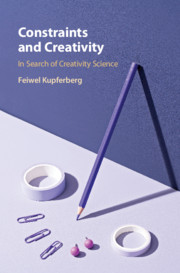Book contents
- Constraints and Creativity
- Constraints and Creativity
- Copyright page
- Contents
- Prolegomenon
- Preface
- Introduction
- Part I In Search of Creativity Science
- Chapter 1 What is Science? What is Creativity and How Are the Two Entangled?
- Part II Elaborating the Theoretical Model
- Part III Conclusions: First Principles of Creativity Science
- References
- Index
Chapter 1 - What is Science? What is Creativity and How Are the Two Entangled?
from Part I - In Search of Creativity Science
Published online by Cambridge University Press: 09 July 2021
- Constraints and Creativity
- Constraints and Creativity
- Copyright page
- Contents
- Prolegomenon
- Preface
- Introduction
- Part I In Search of Creativity Science
- Chapter 1 What is Science? What is Creativity and How Are the Two Entangled?
- Part II Elaborating the Theoretical Model
- Part III Conclusions: First Principles of Creativity Science
- References
- Index
Summary
This chapter basically describes how I arrived at the theoretical model for how to analyze or interpret concrete cases of pioneering work. For a creativity science to be possible, we must broaden our knowledge base and avoid the temptation to study only scientific, artistic or technological forms of creativity or some narrow aspect, the approach of specialized disciplines. Nor should creativity science merely foreground one level of creativity such as pioneers, professionals or novices but ask what constrains the three levels and how the transitions between these levels come about in practice. Creativity science should also avoid the temptation to define creativity as novelty or originality. This is best seen by studying the creativity of nature where creative solutions are characterized by parsimony. Studying n-creativity is also of help to identify the important role of protection of vulnerable versions and recognize Aristotle as the founder of creativity science.
Keywords
- Type
- Chapter
- Information
- Constraints and CreativityIn Search of Creativity Science, pp. 21 - 48Publisher: Cambridge University PressPrint publication year: 2021



